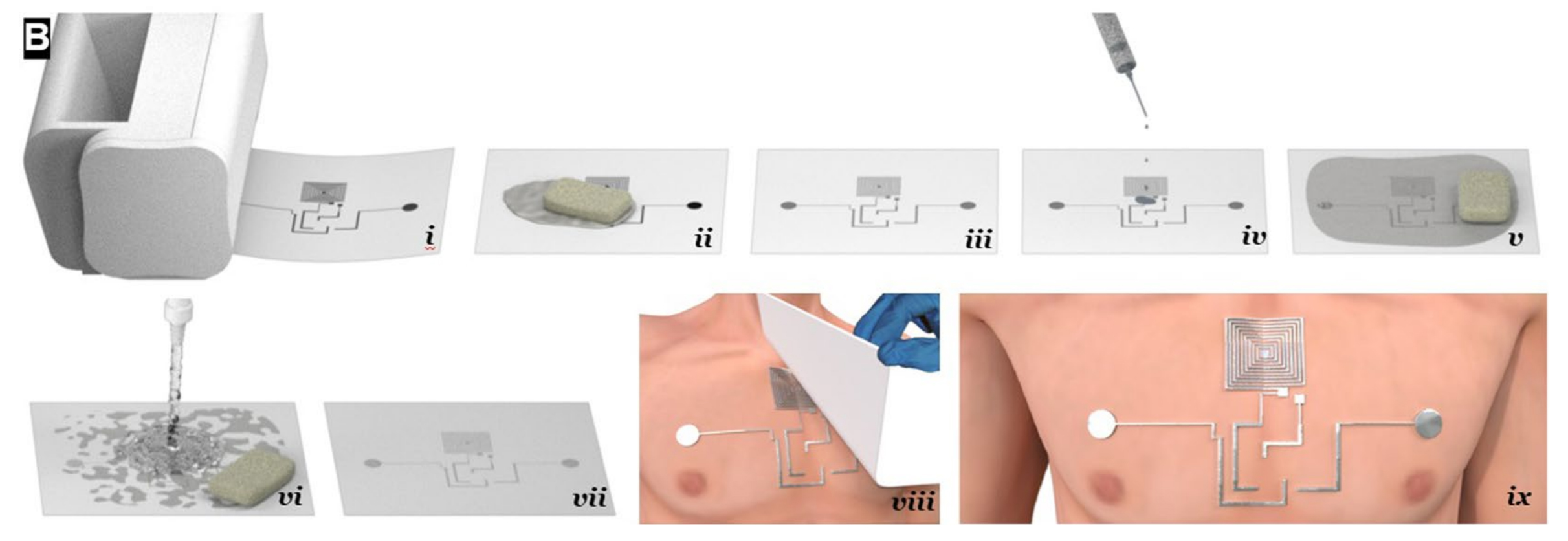fully Untethered Battery-free Biomonitoring electronic tattoo with Wireless energy Harvesting.
José Alberto
Cristina Leal
Cláudio Fernandes
Pedro A. Lopes
Hugo Paisana
Aníbal T. de Almeida
Mahmoud Tavakoli
Bioelectronics stickers that interface the human epidermis and collect electrophysiological data will constitute important tools in the future of healthcare. Rapid progress is enabled by novel fabrication methods for adhesive electronics patches that are soft, stretchable and conform to the human skin. Yet, the ultimate functionality of such systems still depends on rigid components such as silicon chips and the largest rigid component on these systems is usually the battery.
In this work, we demonstrate a quickly deployable, untethered, battery-free, ultrathin (~5μm) passive “electronic tattoo” that interfaces with the human skin for acquisition and transmission of physiological data. We show that the ultrathin film adapts well with the human skin and allows an excellent signal to noise ratio.

Te ECG patch includes energy harvesting coil, two skin interfacing bio-potential electrodes, and a re-utilizable battery-free electronic circuit for data acquisition, processing, and communication. (i) Example of the “Data-By-Demand” system. By approaching the mobile device, the electronic tattoo receives the required energy and wirelessly communicates physiological data such as heartbeat and body temperature to the same mobile device (ii).

Steps for fabrication of the printed ultrathin disposable electronic tattoo. Printing the circuit pattern using an ordinary laser printer and black toner over transfer tattoo paper (i). A silver epoxy is deposited and rubbed with a fabric (ii) rubbing is continued until the excess is removed. Ag bonds selectively to the laser printed pattern (iii). Trace amount of Liquid metal is deposited (iv), spread (v), and cleaned with a weak acetic acid solution (vi). LM wets selectively the parts with the Ag. (vii). The circuit is applied to the skin and is wet by a fabric. The backing paper is removed (viii), and the ultrathin polymer carrier with the circuit facing to the skin is transferred to the skin (ix).
Comparison between the “tattoo electrodes”, Ag/AgCl electrodes and Stainless Steel electrodes. (A) Acquired signal during ECG and EMG comparison of the electrode-skin impedance for different electrodes, average and std of 5 acquisitions, for Ag/AgCl electrodes (i), Stainless Steel electrodes (ii) and “tattoo electrodes” (iii). (B) Te model used in the analysis (i), the value of RS (ii), Rd (iii) and Cd (iv). (C) Comparison of Signal to Noise ratio during ECG acquisition for 5 measurements (i), and the skin-electrode impedance (ii). The representation of a conformable interface vs a non-conforming interface (iii).


The concept for an implanted biomedical device with a near-field energy harvesting coil (A), schematics of the experiment performed to simulate the effect of porcine skin in between the receiver and transmitter coil (B) and results of the simulation comparing the power output with and without pork skin in between the coils (C).

Picture of the built prototype transferred to the skin being used to transmit the ECG information (A) and the ECG signal received by the computer with the beats-per-minute (BPM) information (B).
fully Untethered Battery-free Biomonitoring electronic tattoo with Wireless energy Harvesting.
Alberto, J., Leal, C., Fernandes, C. et al. Fully Untethered Battery-free Biomonitoring Electronic Tattoo with Wireless Energy Harvesting. Sci Rep 10, 5539 (2020). https://doi.org/10.1038/s41598-020-62097-6

